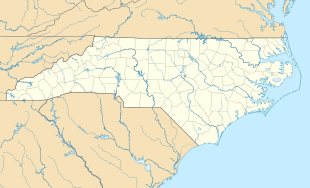Fort San Juan (Joara)
| Fort San Juan | |
|---|---|

A portion of a 1584 map by Geronimo Chaves depicting the site of "Xuala" where, in 1567, Juan Pardo established Fort San Juan.
|
|
| Location | Morganton, North Carolina |
| Coordinates | 35°49′27″N 81°44′1″W / 35.82417°N 81.73361°WCoordinates: 35°49′27″N 81°44′1″W / 35.82417°N 81.73361°W |
| Built | 1567 |
| Demolished | 1568 |
| Owner | Privately owned |
Fort San Juan was a late 16th-century fort built by the Spanish under the command of conquistador Juan Pardo in the native village of Joara, in what is now Burke County, North Carolina. Used as an outpost for Pardo's expedition into the interior of what was known to the Spaniards as "la Florida", Fort San Juan was the foremost of six forts built and garrisoned by Pardo in modern-day North Carolina, South Carolina, and Tennessee to extend Spain's effective control deeper into the North American continent.
Fort San Juan was the first European settlement in North Carolina and the interior of present-day United States, predating the earliest British settlement at Roanoke Island, North Carolina by 18 years. In 1568, natives from Joara and the region surrounding the fort razed this and the five other Spanish forts, killing all but one of the soldiers.
After the fort's destruction, its exact location was lost. Archaeological work has been underway for years, revealing artifacts suggestive of Spanish settlement. During the summer of 2013, archaeologists affiliated with the University of Michigan, Tulane University and Warren Wilson College announced that they had discovered evidence of a defensive moat and other remains, definitive evidence of Fort San Juan.
In 1566, a fleet under the command of Pedro Menéndez de Avilés established the coastal mission of Santa Elena on what is now Parris Island in South Carolina. Santa Elena was established to be the headquarters for further Spanish expeditions into the interior of North America, and in this vein, Avilés ordered conquistador Juan Pardo to explore the interior of the new territory, and to find an overland route to Spain's silver-rich holdings in Zacatecas, Mexico, located within what was known as the Viceroyalty of New Spain. Pardo's expedition set out from Santa Elena in December 1566, and followed the routes of the Congaree and Wateree rivers up to the native city of Cofitachequi, which had been visited 26 years prior by Hernando de Soto. The expedition continued along the Wateree past where it becomes the Catawba River (in modern-day naming conventions), arriving in 1567 at the Native American city of Joara (spelled "Xuala" in later Spanish maps).
...
Wikipedia

